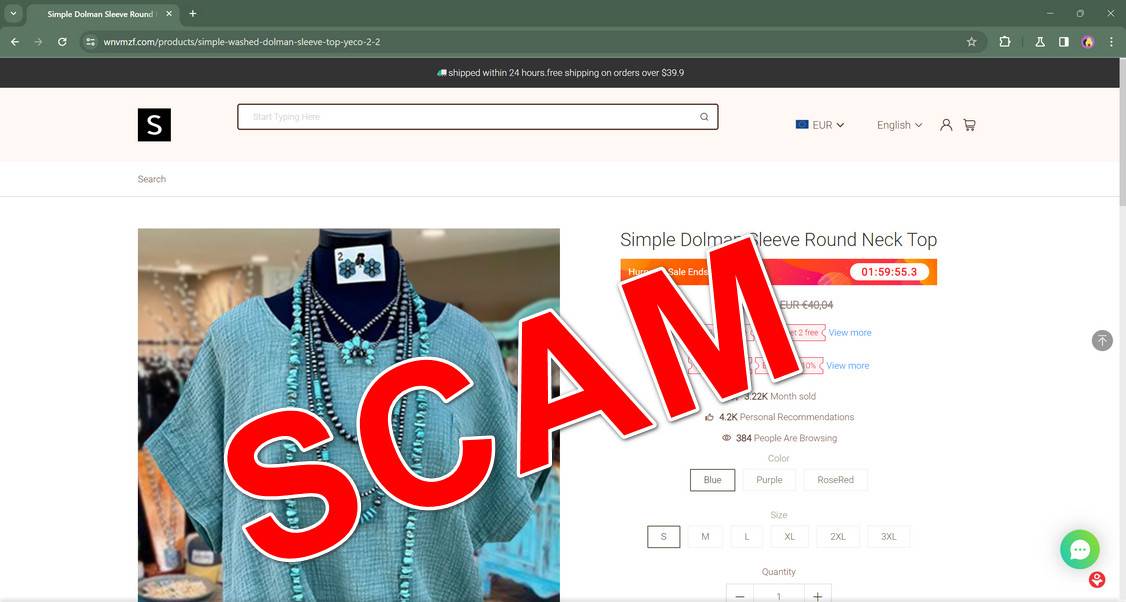As the leading online fashion retailer beloved by Gen Z shoppers for its affordable and trendy clothing, Shein has unfortunately become the latest victim of elaborate clearance sale scams promoted online. Sophisticated fake websites and social media ads falsely claiming to offer extreme Shein discounts up to 90% off popular items aim to dupe deal-seeking shoppers. This guide breaks down exactly how this scam ensnares victims plus tips to avoid exploitation.






Overview of Sophisticated Fake Shein Clearance Sales Conning Shoppers
The real Shein experience needs no introduction, having perfected fast fashion ecommerce by turning social media inspiration into affordable apparel orders shipped directly to over 150 million loyal customers globally. However, Shein’s immense popularity is attracting sophisticated clearance sale scams.
Highly-convincing fake Shein websites engineered to precisely mimic Shein’s real online store down to matching logos, product shots and web design are being heavily marketed through social media ads. They tout unrealistic limited-time blowout apparel markdowns up to 90% off to spark interest and website traffic.
Common Clearance Scam Warning Signs:
- Extreme 90%+ discounts too good to be true
- Suspicious URLs slightly differing from real site
- Poor grammar, spelling errors and unprofessional site text
- Non-working customer service phone numbers and addresses
When lured onto these deceptive clearance domain knockoffs instead of legitimate Shein itself, victims who place orders overwhelmingly report profound disappointment through:
- No items shipped – Most likely outcome after payments processed
- Cheap knockoffs – Low-quality fakes that don’t match product images/descriptions
- Used or damaged goods – Showing clear signs of previous wear and abuse
- Random wrong items – Products not even ordered!
And adding insult to injury, users’ personal and financial data also gets stolen during checkout on these elaborate sham websites enabling additional downstream identity theft by fraudsters.
By understanding the cunning techniques these sophisticated Shein clearance scams deploy online, shoppers can sidestep their tricks and securely shop the real website.
Step-By-Step: How Users Get Scammed By Fake Shein Blowouts
Successfully scamming shoppers using counterfeit Shein online promotions requires coordinated planning and execution. Here is exactly how innocent victims get duped:
1. Scammers Architect Fake “Shein” Online Stores
Sophisticated scam artists build intricately designed replica Shein websites made to mirror the fashion retailer’s real digital flagship shop.
While URL addresses appear legitimate on the surface, they actually utilize similarly named domains diverting traffic away from real Shein stores:
sheinoutletstore.online
sheinwebsaleretail.shop
sheinshoponline.siteThe elaborate fake sites similarly use Shein’s exact logo, product galleries and familiar website navigation – while barely differing enough to control mimic domains.
2. Bogus Shein Clearance Sale Ads Promoted Via Social Media
Fraud ring operators then promote their network of sham Shein domains using compelling social media ads highlighting unbelievable deep discount messaging to fool users. These primarily leverage Facebook, Instagram and TikTok due to immense Gen Z reach.
The ads run exaggerated headlines like “Shein warehouse closing – up to 90% off everything during final clearance event before we shut down!”. Links then route through obscured URL shorteners masking the underlying scam destinations.
When social media users click on these advertisements, they get redirected to the sophisticated fake clearance stores instead of legitimate Shein websites.
3. Shoppers See Outrageous Prices Slashed Over 90% Off
Upon landing on the convincing duplicate Shein domains, visitors behold what appears as incredible clearance sales boasting extreme 90%+ reductions.
Genuine Shein graphic tees, hoodies, dresses and pants all show insanely marked down from $30+ retail rates to just $3-5 bucks – making on-trend wares seem virtually free compared to real Shein prices.
Such irrational price points are shown next to much higher standard Shein pricing for authenticity. This further fools visitors into assuming the blowout deals are authorized limited-time fire sales.
4. Checkout Forms Steal Users’ Financial and Personal Data
As shoppers rush to checkpoint unbelievable bargain hauls, mandatory order forms demand extensive sensitive customer data including:
- Full legal names
- Home addresses
- Phone numbers
- Credit card numbers
- Security codes
- Expiration dates
This mined contact/payment data flows directly to sophisticated scammers rather than legitimately securing clearance grab deals.
5. No Orders Fulfilled or Terrible Products Received Instead
Soon victims find they got scammed when clearance orders never arrive. Instead purchases either:
- Vanish entirely after payments with zero fulfillment
- Extremely poor quality knockoffs get shipped instead
- Used, defective merchandise arrives instead
- Random wrong products show up unrelated to orders
Now victims lack real products while fraudsters possess both stolen money and sensitive personal data enabling additional identity theft downstream.
How to Spot Counterfeit Shein Clearance Websites
While scam sites tout unbelievable markdowns, closer inspection reveals their fraudulent nature once aware of their tactics.
1. Analyze Website URLs
Fake domains barely differ from the real Shein.com:
sheinoutletstore.online
sheinstoresale.shop
sheinblowoutsale.siteMost are recently created in 2021/2022 based on domain age checks.
2. Review Contact Information
No physical addresses or phone numbers provided by sites – only dubious email addresses:
support@sheinoutletstore.online
service@sheinstoresale.shop Non-transparency signals shady operations.
3. Assess Pricing Claims
Prices seem unbelievable compared to real Shein’s already affordable rates. Items are discounted 90% off from $30+ prices down to just $3 apiece.
4. Scrutinize Branding and Slogans
Shein’s bubble logo, signature fonts and slogans are used liberally:
- “Massive storewide clearance savings!”
- “Limited-time free shipping”
But branding elements appear edited when inspected closely exposing fakery.
Staying observant for these fake signals makes avoiding clearance sale scams achievable when bargain hunting online.
How to Catch Fake Shein Ads on Social Media
Fraudulent Shein ads on popular platforms frequently employ unbelievable “90% off” slogans and enticing phrases like “Flash sale!” to manipulate shoppers. But their repeatable patterns expose bogus natures.
Dubious Facebook Ad Discounts Are Manipulation Ploys
Watch for Facebook ads boasting:
- “Blowout clearance sale – today only deals!”
- “Hurry, store closing forever – everything 90% off!”
Other red flags include stolen branding, odd links, disabled comments and fake influencer images. Cross-checking helps identify falsified Facebook ads.
Instagram Ad Messaging Preys On Bargain Shopper FOMO
Scam Instagram ads touting:
- “Last chance for rock bottom clearance steals!”
- “Final sale – Going out of business forever!”
Be skeptical of engagement inconsistencies, off-platform redirects and urgency cues. Understanding behaviors reveals Instagram fakes.
TikTok Video Tactics Pressure Immediate Action
Counterfeit video ads demonstrate these consistent red flags:
- Fake deepfake creator footage instead of showing real stores/products
- Graphics listing suspicious site URLs
- Brand impersonations in channel names
- Comment disabling
Despite potential high visibility, typical scam ad characteristics make real vs fake discernment achievable on TikTok.
Scammers manipulate discounts, sales events and slogans frequently. But awareness of repeatable suspicious patterns empowers avoidance of clearance cons.
What To Do If Scammed By a Fake Shein Blowout
If you unfortunately got tricked by a deceitful fake Shein clearance promotion online, immediately take these steps to mitigate damages:
Report Fraudulent Transactions: Call the credit card provider used on scam sites ASAP. Request they reverse any illegal purchases for undelivered goods. Provide details surrounding the sham websites and failed delivery.
Initiate Credit Reports Freeze: Since personal data also got compromised, freeze credit reports at Equifax, Experian and Transunion stopping criminals opening unauthorized new accounts.
Monitor Financial Account Activity: Watch statements routinely for fraudulent charges indicating potential identity theft after being scammed. Notify institutions immediately regarding any suspicious transactions.
Report Fake Websites: Submit details on scam websites encountered to the FBI’s IC3 Complaint Center and FTC’s reporting page to combat retail cons.
Getting exploited by online shopping scams feels awful. But responding swiftly helps restrict damages while preventing additional trickery through frozen credit and fraud reporting.
Frequently Asked Questions About Fake Shein Clearance Sales
Concerned about counterfeit Shein clearance sales duping online shoppers? This FAQ tackles the most common questions about identifying and avoiding this clothing and accessories scam.
Are the Shein 90% off clearance sales on Facebook legitimate?
Unfortunately most are completely fraudulent despite appearing convincingly affiliated with the Shein brand. Scam ads actually route traffic to elaborate fake lookalike websites to steal personal/financial data instead of enabling sales. Always verify URLs match Shein’s real site before assuming discounted offers are genuine.
What are common signs of a fraudulent Shein clearance website?
Warning signs include non-Shein URLs, recent domain creation dates, subtle branding/logo issues, unprofessional errors in site text, mismatching images and no working customer service contacts.
What happens if you order from a fake Shein clearance domain?
Most likely your order disappears entirely after payment and nothing ever ships. In other cases, victims received flimsy knockoffs, used goods or random products unrelated to original orders. Plus all submitted personal data during checkout gets stolen enabling future identity fraud exploits.
Can you get money back if scammed by an imposter website?
If you paid with a credit card, immediately file a fraud complaint requesting reversal of charges. Unfortunately debit cards provide less fraud protection through banks, making reimbursement less likely.
How can I avoid Shein clearance sale scams moving forward?
Carefully verify site legitimacy and URLs before providing payment information or checkout. Official Shein domains must match their real website address precisely. Additionally realize unbelievable discounts like 90% off are universally fraudulent.
Will my identity get stolen from ordering on counterfeit sites?
Possibly – we strongly advise placing fraud alerts on credit reports, monitoring accounts routinely and securing credentials if exploited. Stolen financial information enables various identity theft ploys when obtained by fraudsters.
Where should I report fraudulent Shein websites?
To prevent ongoing victimization, report fake sites and sellers to the FBI’s IC3 complaint center and FTC’s reporting page. Include all website and order details.
Stay vigilant of unbelievable Shein social media and website sales. Scammers aggressively exploit the brand’s popularity with young shoppers.
The Bottom Line – Verify Before Providing Data to Shein Blowout Claims
As Shein retains immense popularity for fast fashion apparel and accessories relied on by millions of Gen Z shoppers globally, their iconic branding remains an alluring target for clearance sale scammers seeking to deceive eager deal searchers through elaborate fakes. But proactively verifying legitimacy remains the ultimate self-defense.
Carefully check URLs match Shein’s real domain while watching for other common scam warnings covered here before assuming authenticity or providing data. Question improbable rock bottom pricing on alleged limited-time sales not aligned with Shein’s already affordable rates.
And never submit personal/financial data without thoroughly vetting sites first, even if branding appears officially affiliated on the surface. Staying vigilant for common online shopping scam indicators makes avoiding clearance sale tricks much easier. Think twice when unbelievable deals arise unexpectedly.










